The Early Middle Ages
Byzantine Empire
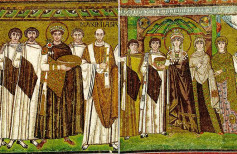 Similar to polity and culture, clothing in Byzantium was also heavily influenced by the heritage of Ancient Rome. Thus, the Byzantine court costumes had all the major features of clothing of Ancient Rome. Men wore double tunics, one over the other, which were, depending on the period, long or short. Under the tunics, they wore fluttering trousers of Persian origin (chlamyda). Short hair and shaved faces were fashionable until 8th century, when, under the eastern influence, beards become popular once more.1
Similar to polity and culture, clothing in Byzantium was also heavily influenced by the heritage of Ancient Rome. Thus, the Byzantine court costumes had all the major features of clothing of Ancient Rome. Men wore double tunics, one over the other, which were, depending on the period, long or short. Under the tunics, they wore fluttering trousers of Persian origin (chlamyda). Short hair and shaved faces were fashionable until 8th century, when, under the eastern influence, beards become popular once more.1
Female clothing was also inspired by Roman culture, and it also consisted of double tunic. The outer tunic was sometimes lifted sidelong from ankles to knees to show the wide cloth tape between the tunics (pagatium). Hair style was in Greek fashion, and it was additionally decorated by ribbons, a distinctive skullcap (calautica)or a long veil with fringes (mavort).2 Byzantine ladies also garnished themselves with rich and expensive jewelery.
The difference between Roman and Byzantine garments, however, was mostly emphasized by the fabrics used. Since Byzantium had a major role in trading between East and West, Byzantine clothes were made mostly of eastern fabrics, such as Chinese silk, Egyptian cotton and flax, colorful, richly decorated by floral motifs, various fantasy animal characters etc.3
European nations
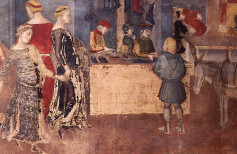 Nations of northern Europe lived in a colder area, thus they wore warmer clothes. A typical example of their garments were woolen trousers of different shapes, that were long and wide, and sometimes required a belt for tightening in the lower region. Typical outfit of these nations consisted of an undertunic, a shirt, trousers, an outer tunic and a robe. It was often made out of fur, thus it was used to make entire pieces of outfit or for decorational purposes.6 These garments were very colorful, with an exception in Acquitania, in which people mostly wore fabrics that were black or brown.5
Nations of northern Europe lived in a colder area, thus they wore warmer clothes. A typical example of their garments were woolen trousers of different shapes, that were long and wide, and sometimes required a belt for tightening in the lower region. Typical outfit of these nations consisted of an undertunic, a shirt, trousers, an outer tunic and a robe. It was often made out of fur, thus it was used to make entire pieces of outfit or for decorational purposes.6 These garments were very colorful, with an exception in Acquitania, in which people mostly wore fabrics that were black or brown.5
In medieval Gaul both men and women also wore tunics. Women wore underskirts, whilst men added a kind of long underpants, which were tightened by a belt in the waist (braies). On their feet, they wore closed shoes made of leather, with wooden outsoles (gallicae). An interesting fact is that Gauls often painted their hair red, and men wore goatees and long mustache.6
A historical twist in clothing style came with Germanic people, whose clothes were, opposed to Roman, more adjusted and embroidered to fit the shape of the body. This can also be considered as a beginning of today’s western fashion.7
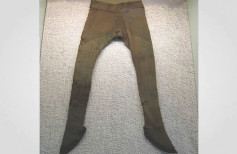 Vikings wore trousers and a long-sleeved shirt, over which they wore tunic tightened in the waist. In winter, a furry cloak or a woolen overcoat was often worn over. They covered their heads with leather, woolen or furry hats, to protect themselves from the cold. Viking women were much respected in society, especially compared to the rest of Europe, which also makes a certain detail of their clothes rather interesting. Namely, as a sign of domestic authority, they wore their keys on a chain that hung from their belt or a belt buckle.8
Vikings wore trousers and a long-sleeved shirt, over which they wore tunic tightened in the waist. In winter, a furry cloak or a woolen overcoat was often worn over. They covered their heads with leather, woolen or furry hats, to protect themselves from the cold. Viking women were much respected in society, especially compared to the rest of Europe, which also makes a certain detail of their clothes rather interesting. Namely, as a sign of domestic authority, they wore their keys on a chain that hung from their belt or a belt buckle.8
Frankish clothes during the Merovingian dynasty consisted of wide gaul underpants and short tunic (gonella), under which the Franks wore leather trousers (chausses) that had ribbons to tie around the legs. Women wore broad tunics decorated with ribbons or embroidery, over which they usually wore robes during cold weather. Both men and women had long hairs, but married women gathered their hairs in a bun.9
In Carolingian period male clothing remains unchanged, but the hairstyle is different – hair is cut short as in Ancient Rome. Women wore double tunics, one over the other, of which the under one was narrow with long sleeves, and the one over it was broader with short sleeves. They were tightened in the waist, and were additionally secured and decorated by a fibula on the shoulder.10
Although the analysis of the dressing styles of early Medieval Europe shows similarities between differ rent nations, with jewellery this is not the case. Every nation wore characteristical ornaments, i.e. Celts wore abstract patterns, while the Anglo-Saxons preferred animalistic patterns.11
Romanesque
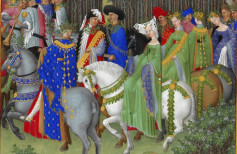 During the period of the Romanesque there was no significant changes in clothing. It remained very similar to Carolingian, and a slight change happened only by the middle of the 12th century, when long outfits came into general use.
During the period of the Romanesque there was no significant changes in clothing. It remained very similar to Carolingian, and a slight change happened only by the middle of the 12th century, when long outfits came into general use.
Tunic remains the main part of both male and female clothing, thus the characteristical outfit consists of long undertunic (chainse) which has narrow long sleeves, and a shorter tunic on top of it (bliaud) which has short, broader or narrower sleeves. The top tunic was additionally tightened in the waist, and it was decorated with ribbons or embroidery. Women’s tunics were narrower and shorter than the men’s, and they consisted of a narrow shirt that tied in the back or on the side (gipon), and frilled skirts. The waist was belted with a leather or a silk belt, which hung all the way to the ankles. The sleeves on the top tunic extended through time, until they finally reached the ground in the middle of the 11th century.12 Other parts of the outfit, such as various robes and pelerines, remained the same.
Gothic
The clothes that were worn during the Romanesque, with some minor novelties, remain the same in Gothic period. The novelty, however, are long woolen tunics in vivid colors. There were a few types, for example: longer and shorter doublet adjusted to a broader skirt worn by both genders, then, a shirt with narrow sleeves for the upper body, and a long hooded robe with wide and narrow sleeves.13
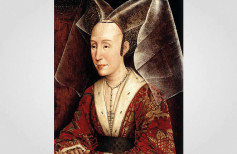 Nonetheless, in the middle of the 14th century there is a fundamental change. Up until then, both genders’ outfits were rather similar, since it did not accentuate the body line. Now, however, there is a major breakthrough in men’s clothes which become shorter, they’re embroided and stitched to follow the shape of the body, while the women’s clothes remain long and swaying. Men start to wear a kind of narrow coatee (pourpoint) that stretched to the thighs, and buttoned on the front, and was tightened in the waist by a stitch. It was worn over a shirt and very short trousers (haut-de-chausses). By the end of the 14th century, it was replaced by a similar garment (jaquette) with open sleeves which were prolonged with cloth ribbons that sometimes stretched down to the knees. Women continued to wear long outfits, but through time they became shorter. Dresses were skintight in the chest, with open triangle-shaped cut.14
Nonetheless, in the middle of the 14th century there is a fundamental change. Up until then, both genders’ outfits were rather similar, since it did not accentuate the body line. Now, however, there is a major breakthrough in men’s clothes which become shorter, they’re embroided and stitched to follow the shape of the body, while the women’s clothes remain long and swaying. Men start to wear a kind of narrow coatee (pourpoint) that stretched to the thighs, and buttoned on the front, and was tightened in the waist by a stitch. It was worn over a shirt and very short trousers (haut-de-chausses). By the end of the 14th century, it was replaced by a similar garment (jaquette) with open sleeves which were prolonged with cloth ribbons that sometimes stretched down to the knees. Women continued to wear long outfits, but through time they became shorter. Dresses were skintight in the chest, with open triangle-shaped cut.14
In this period, women’s hairstyles are more extravagant than before, which outraged the ecclesiastical community. The hair was braided or gathered on the temples. At first, it was covered by a light veil (huve), but the hair volume later grew, so hairs with horns, decorated with so-called truffeauxs, came to popularity. Hairs continued to grow, until the horn reached heights of around sixty centimeters (hennin), which was covered with veils or velvet ribbons, that were fashionable in the middle of the 15th century.15
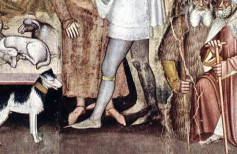 At the same time, the shoes have also grown extravagantly. Namely, they have stretched so long that the front end was sometimes fastened to the knee with a small chain in order to enable normal walk. They become pointy in the front, and are curved, forming an arc which bent towards the leg.16
At the same time, the shoes have also grown extravagantly. Namely, they have stretched so long that the front end was sometimes fastened to the knee with a small chain in order to enable normal walk. They become pointy in the front, and are curved, forming an arc which bent towards the leg.16
In this period, clothes were more and more a way to show wealth and luxury, along with the extravagance of nobility. The fashion center of that time was Burgundian court. Accordingly, in time new laws are appointed to ban luxury to gentry and citizenry. French king Philip the Fair issued an order in 1294 by which he restricts the number of robes for dukes, earls, barons and other classes according to their land revenues, and bans all canescent fur, ermine, gold and jewelery to citizenry. Similar orders were issued all over Europe.17 The clothes and attitude of monks towards the fashion of that time is described in the following excerpt from 14th century „Chronicles of Saint Denise“: „ … Arrogance was enormous in France, amongst nobility: in the disdain of gentlemen, in the greed for fortune, in the indecency of clothing and outerwear which was commonly worn in French Kingdom. For, some had short robes stretching only to their thighs, and when they would bend over in order to serve a nobleman, they would reveal their undergarments and whatever was in them to the people behind. And when they were so narrow that they needed help to put them on and take them off, it would seem as if they were skinning them alive while undressing them. And the others had dresses frilled on the hips like women. And these had hats with a slit rim all around. They wore trousers with legs of different fabrics…“.18
Common people’s clothes
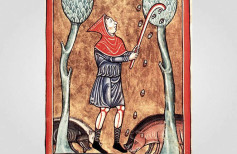 The clothes of the common people differred from the ones that the noblemen wore, and they improved, i.e. changed, more slowly. Long-sleeved tunic remained the basic garment throughout the Middle Ages, which on women descended down to the solei, and on men to the knees. Women also wore veils with which they covered their head and shoulders, which were later in the 14th century substitued by a simple hat. In winter, they wore a leather vest made of rabbit’s, lamb’s, goat’s or cat’s skin. Men wore long shirts and a kind of ordinary short trousers. The clothes were mostly made of coarse fabric.19
The clothes of the common people differred from the ones that the noblemen wore, and they improved, i.e. changed, more slowly. Long-sleeved tunic remained the basic garment throughout the Middle Ages, which on women descended down to the solei, and on men to the knees. Women also wore veils with which they covered their head and shoulders, which were later in the 14th century substitued by a simple hat. In winter, they wore a leather vest made of rabbit’s, lamb’s, goat’s or cat’s skin. Men wore long shirts and a kind of ordinary short trousers. The clothes were mostly made of coarse fabric.19
From this short review of Medieval clothing we can see that in this millennium fashion did not go through some excessive changes, and the clothes of both genders were much alike. However, by the end of this period, in the 15th century, we can already see some indications of fashion blossom that will happen in the Renaissance.
- The clothes of both men and women in Middle Ages did not distinguish much, and the basic garments were various sorts of tunics.
- Gauls found it fashionable to color their hair in red.
- In Gothic period, shoes with pointy ends were rather common, which were sometimes so long that the front end had to be fastened to the knee by a small chain in order to enable normal walk.
- Franҫois-Marie GRAU, Povijest odijevanja, Kulturno informativni centar, Naklada Jesenski i Turk, Zagreb, 2008
- Gillo DORFLES, Moda, Golden Marketing, Zagreb, 1997
- L. ROWLAND-WARNE, Odjeća, Knjiga trgovina, Zagreb, 1996
- John PEACOCK, Povijest odijevanja na Zapadu, Golden marketing-Tehnička knjiga, Zagreb, 2007
- 1 Franҫois-Marie GRAU, Povijest odijevanja, Kulturno informativni centar, Naklada Jesenski i Turk, Zagreb, 2008, 24.
- 2 Franҫois-Marie GRAU (note 1), 25.
- 3 Franҫois-Marie GRAU (note 1), 25.
- 4 L. ROWLAND-WARNE, Odjeća, Knjiga trgovina, Zagreb, 1996, 12.
- 5 Franҫois-Marie GRAU (note 1), 27.
- 6 Franҫois-Marie GRAU (note 1), 27-28.
- 7 Franҫois-Marie GRAU (note 1), 28.
- 8 L. ROWLAND-WARNE (note 4), 13.
- 9 Franҫois-Marie GRAU (note 1), 28-29.
- 10 Franҫois-Marie GRAU (note 1), 29.
- 11 L. ROWLAND-WARNE (note 4), 12.
- 12 Franҫois-Marie GRAU (note 1), 31-32.
- 13 Franҫois-Marie GRAU (note 1), 33.
- 14 Franҫois-Marie GRAU (note 1), 33-34.
- 15 Franҫois-Marie GRAU (note 1), 34.
- 16 Franҫois-Marie GRAU (note 1), 34.
- 17 Franҫois-Marie GRAU (note 1), 34-35.
- 18 Franҫois-Marie GRAU (note 1), 36.
- 19 Franҫois-Marie GRAU (note 1), 37-38.
Your comment